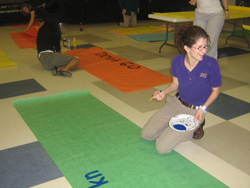February’s International Reading Association (IRA) Member of the Month is Brandie McNabb, second grade teacher and President-Elect of the Louisiana Reading Association, the host state of the IRA 59th Annual Conference to be held in New Orleans from May 9-12, 2014. Reading Today caught up with Brandie to ask her about her plans for the conference in her home state, her experiences as Teacher of the Year and a National Board Certified teacher, why she loves Dr. Seuss, and her thoughts on why to become and why not to become a teacher!
When did you know you wanted to become a teacher?
 I always wanted to be a teacher. I can remember helping my aunt set up her classroom each summer. It seemed like the coolest job ever! I had many people trying to influence me to pursue other fields. I unfortunately listened to them when I first finished college, but I finally did come back to what I feel was my calling in life.
I always wanted to be a teacher. I can remember helping my aunt set up her classroom each summer. It seemed like the coolest job ever! I had many people trying to influence me to pursue other fields. I unfortunately listened to them when I first finished college, but I finally did come back to what I feel was my calling in life.
Which children's literature books influenced your decision to become a literacy educator?
Anything by Dr. Seuss! He felt that children’s books were boring and wondered why anyone would want to read a boring book. Amen! Whether it makes you laugh or cry, there is nothing like a good book. The best feeling is to read a book to my class and see their anticipation of what the next page has to say.
How did you begin your career, and what led you to your current position?

Oh that’s a great question! As I mentioned, I wanted to be a teacher even in high school. But also I had a friend whose mom was a teacher. She said, “Don’t do that. You won’t make any money.” I listened and ventured off to nursing school. When it was time to begin my clinical work, I realized that wasn't what I wanted to do for the rest of my life. I finished college with a General Studies degree. I worked in a pharmacy for several years before realizing I still felt that calling to be a teacher. I found out about an Alternate Certification Program in education. The rest is history. I’m currently getting my masters in Curriculum and Instruction.
I’ve been in my current position, second grade, for eleven years. My school district has only been in existence for eleven years. I was lucky to be with them from the beginning. Our school district doesn’t have neighborhood schools but has grade level clusters, which I think is part of the key to our success. We’ve been the number one district in our state for the past eight years. My school has only first and second grades, which means every child in our district will attend our school.
What can literacy educators do to motivate kids to want to read?
Help them find the right book! Many times, teachers give the students the books to read. Letting students choose what they want to read is giving them a voice. In my reading groups, I provide them with books on their instructional level, but I always make sure that they get to pick books to bring home too.
How long have you been a member of the International Reading Association? How has membership influenced your career?

I’ve been a member of IRA for over ten years. At first, it was just to attend conferences, but I slowly became more and more involved. In 2008, I started the local reading council in my school district. I wanted to give reading teachers in our district an opportunity to come together and talk. It was a way to learn the latest and best methods without leaving our schools. Through ZARC, I’ve become active in the state’s council, Louisiana Reading Association (LRA). I’ve developed some great friendships with some great leaders in reading. Janet Langlois was the first person I met when I first started researching the possibility of creating a council. She took time to meet with me and provided an enormous amount of help in the process. As the President-Elect for LRA, I hope to honor Janet's memory by making her and my other new found friends proud.
What are you looking forward to doing at the Annual Conference in New Orleans?
Oh, there’s so much! Of course I have to mention the exhibit hall; what teacher doesn’t love exploring the new books, meeting the authors, and collecting lots of free stuff? I enjoy looking through the program and studying which sessions I want to attend. It’s exciting and frustrating at the same time because I can’t be in three places at once! Discovering new ideas, learning about new technology, and making connections with other literacy teachers just amplify the event.
What do you consider to be your proudest career moment?
That’s a hard question to answer and pick one. It was an honor to be picked Teacher of the Year several years ago by my colleagues. Achieving National Board Certification was a highlight too, but I honestly think what is most rewarding is getting those e-mails from former parents or seeing former students. It means the world when they take the time to let me know how they are doing and how they still love to read. Knowing that parents want their kids in my class lets me know I’m doing my job and is the biggest reward I could ever receive.
What do you like to do when you're not wearing your educator hat?
 I love spending time with my family, traveling, reading, and trying to not think about school. I have two girls, ages eight and three. My husband and I love to travel, and we are always dreaming about that ultimate trip.
I love spending time with my family, traveling, reading, and trying to not think about school. I have two girls, ages eight and three. My husband and I love to travel, and we are always dreaming about that ultimate trip.
What's the best advice you could offer someone new to the profession?
Don’t give up; remember why you became a teacher. Dig down deep, and remember why you became a teacher. If it’s because you’re off holidays and weekends, think again. Teachers bring work home constantly. If it’s because you want to make a difference, GO FOR IT! Get involved and stay active either in educational organizations or volunteering for activities at your school. I love to teach reading, even on those bad days. But when you see a child smile because they read the book independently for the first time or made a B on a comprehension test, you’ll remember why you are here.